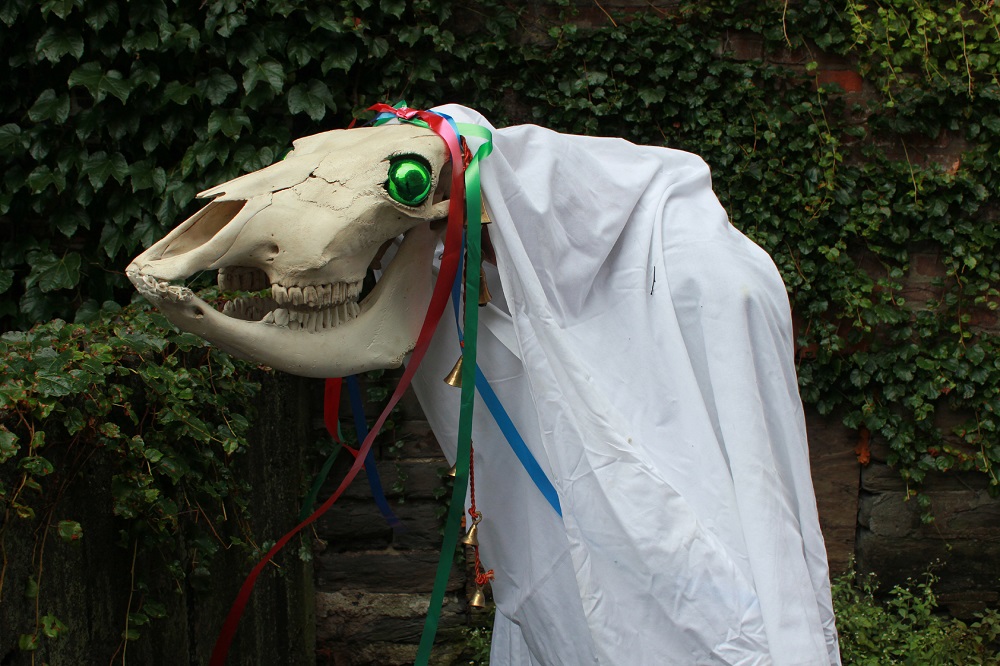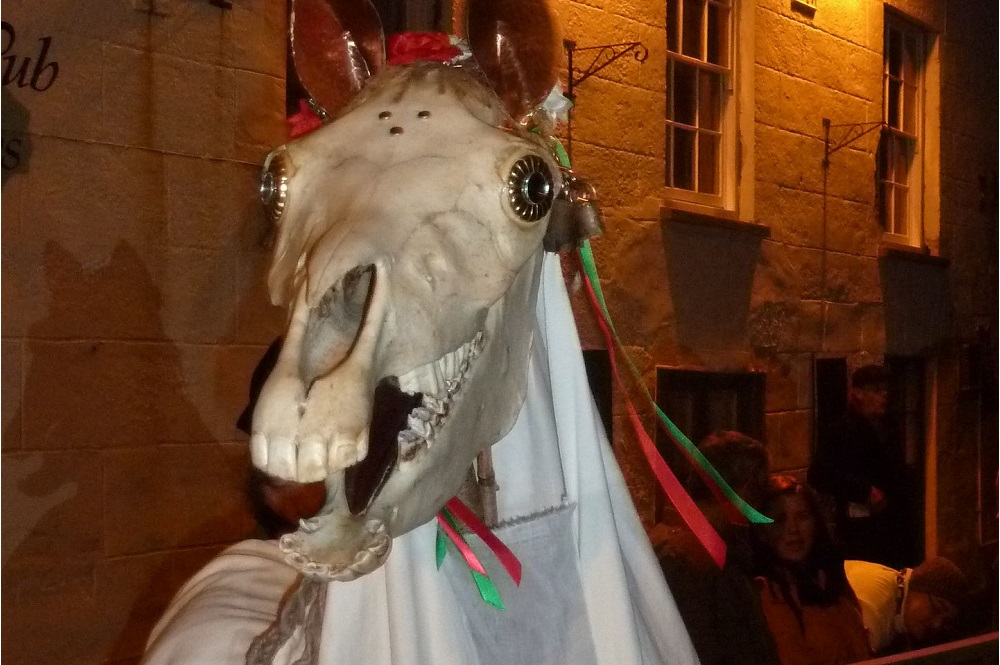It’s Mari Lwyd season – but who owns the tradition?

David R. Howell
New Year celebrations have come and gone, which, in Wales, can mean only one thing – it’s Mari Lwyd season once more. While Covid has played its part in reducing the visibility of the Mari Lwyd in our communities, the tradition continues and arguably has greater coverage (in terms of places where a Mari Lwyd might venture forth) than ever before.
Many a Mari Lwyd are still wandering out, with social media stealing moments of horse skulled revelry; those community groups who are avoiding social gatherings have moved their Mari Lwyd events to online occasions, with Zoom allowing the Mari access to more homes than perhaps ever before.
The tradition of horse head bearing, gang singing, and competitive verse, is thriving, and while this cultural form has clearly evolved to be something distinct from that which was performed even in the late 1980s, let alone any earlier periods, those elements which make the Mari so distinct persist today.
However, there are growing murmurs of discontent among some Mari Lwyd enthusiasts. Nation.Cymru has already covered the debut appearance of the Philadelphia Mari Lwyd, one of many versions of the Mari Lwyd to appear beyond the bounded territory of Cymru. Indeed, in recent years the Mari Lwyd has appeared to be part of contemporary cultural migration across much of the United States, witnessed in California, Kansas, Kentucky and Illinois.
Examples have even been noted in Australia, and that’s not even touching on the vast array of Mari Lwyd manifestations seen throughout England. This vibrant growth of the practice has not, though, been welcomed by all.
Appropriation
Having researched the contemporary Mari Lwyd for the last decade or so, I’ve only seen positive commentary on the growth of the practice. When the Chepstow Mari Lwyd stirred up the structure of the tradition by inviting many a Mari from almost anywhere, so rather than a single skull moving through the town, upwards of thirty phantoms converged on the Old Wye Bridge (before the Chepstow variant seemed to implode on itself, a victim of its own success), nobody raised any concerns – the mere fact that the tradition was being celebrated by so many, with the majority of participating Mari Lwyds coming from across the border, was heralded as a success in promoting the practice to new audiences, keeping (a version) of the tradition alive.
This year though, is the first in which I’ve noted voices of frustration, calling into question the validity of the Mari Lwyd beyond the border.
Perhaps echoing current political trends, corners of social media have finger pointed at the Mari Lwyds of the United States as examples of ‘cultural appropriation’, with suggestions thrown around that the Mari Lwyd outside of Wales, while tolerable, should be named or known by another term.
Given that many of the modern Mari Lwyd variants are found in corners of the States which have strong historical connotations with Welsh migrants, it seems that a valid case could be made for the exporting of a distinct Welsh custom into a community looking to enhance their connections with Cymru.
Yet, in a world (or at least a ‘United Kingdom’) where inward-looking isolationism is the name of the game, cultural forms might be seen to be something that must not just be protected, but ‘owned’. Is the Mari Lwyd not now being something to be enjoyed by the Welsh in the world, but only for the Welsh in Wales? Someone might need to send a memo to the London Welsh centre, who have been practising their Mari Lwyd in the English capital since 2016…

‘Revivals’
Cultural traditions and practice change, grow and move. Indeed their mobility is a critical factor in their long term viability. A tradition anchored to one place, one form of practice or indeed one person, is doomed to inevitable death, as was the case with so many versions of the Mari Lwyd throughout Wales as we moved out of the nineteenth and through the twentieth centuries. A practice that can be carried by one or more people, to new communities, or indeed new countries, is a practice that has the potential to thrive long beyond its source practitioners or, indeed, host community.
Arguably therefore the mobility of the Mari Lwyd concept – a decorated horse skull and assembled singers, not dependent on a specific place or person, has been critical to its survivability. While the modern Mari Lwyd, based around an assortment of bone, papier-mâché, cardboard and (for the first time since I’ve been recording the Mari Lwyd) latex ‘skulls’, is far removed from that which might have been enacted in the nineteenth century, it is the practice of the custom, perhaps more so than the form, which is of critical value.
In this reading of the ‘value’ of the tradition, the ‘where’ of the Mari Lwyd is perhaps of a minor concern. After all, many of the so called ‘revivals’ of the Mari Lwyd, in places such as Anglesey, Llanfihangel Tor y Mynydd, Wrexham, indeed Chepstow itself, are reviving nothing that could be cited in historical accounts for those specific locations. These are not revivals at all, but new cultural expressions, parachuted into parts of Wales which have no historical claim over the tradition, certainly no more so than practitioners in Pennsylvania have to the Mari Lwyd.
Celebrated
We sometimes like to tell ourselves that the Mari Lwyd is ‘ancient’, when it is not; no evidence or argument holds to place any precursor to the Mari in the prehistory of Wales. That it is an expression of the Welsh nineteenth century is important and valuable, without the false addendum of antiquity. Equally so is it important to acknowledge that the Mari Lwyd, in form if nothing else, is not distinct to the geography of Wales. Core elements of the practice are witnessed in the English based hobby horse tradition of earlier centuries.
That is not to say that the Mari Lwyd is English, it is not – but it is a custom which moves, evolves and takes root in other social spheres far beyond whatever ambiguous point of origin it might once have had. That the contemporary Mari Lwyd has spread to the far flung corners of the Welsh diaspora – north America and Australia, broadly speaking, being about as far as you can go from Wales in easterly or westerly directions – is something that should be celebrated, not seen through the lens of suspicion.
No one is trying to steal the Mari Lwyd from Wales, indeed, the growth, adoption and celebration of the tradition is of huge importance to keeping both the Mari alive, and the very concept of Wales being somewhere distinct and recognisable.
So I say let the Mari run free and see where she turns up, Wales and Welsh cultural heritage is in no way harmed or under threat should she go on to disturb the residents of Cape Town, Chengdu or Choibalsan, any more so than when she first made her way through the streets of Chepstow.
Support our Nation today
For the price of a cup of coffee a month you can help us create an independent, not-for-profit, national news service for the people of Wales, by the people of Wales.






Diolch yn fawr David.
Glad you liked it.
Really interesting. The horse deity or whatever you call it is fascinating. I am convinced that that the tradition on farms or houses in west Wales of placing horse head or horse statues at the entrance or gate derives from the older tradition of placing a jawbone or skull in the housr foundations. An early mid 20thC evolution of a folk memory, certainly around the 3 counties of Dyfed. What do you think?
Yeah the horse head under the floor component is really interesting; described as ‘foundation sacrifices’, they crop up a lot more widely than the Mari Lwyd, and was of major significance in Ireland. I’ve read some articles suggesting that the addition of the skull under the floor aided with acoustic qualities of buildings and barns – perhaps there’s a singing component to that as well? However, the practice of the Mari as we would recognise it now isn’t particularly well placed in the west, certainly in terms of recorded examples, and where I am, Pembrokeshire, the historical Mari is almost… Read more »
Thank you for this article, I tend to agree with you, trot on Mari! She was not a tradition in my “bro cartref” here on the north Wales coast, so I was always a bit jealous of her as well as fascinated! There is a mention of a horse skull being placed (by a “dyn hysbys”) under the foundations of a chapel, in the late 1700s, to stop it falling down, it is in the book Coelion Cymru I think.
That is pretty cool – I remember we once excavated an entire horse in Trellech, found in one of the post holes supporting a bridge like structure leading into the castle there; horses turn up in some weird places!
She still appears every (Covid-free) year in Pentyrch, trotting into the Kings Arms after the plygain service in St Catwgs.
A few years back I started to build a map of all recorded, living, Mari Lwyd examples (though I desperately need to update it for this year) – Pentyrch is on there, though glad to hear that it made it through Covid. I’m interested to see how many of the more recent Mari examples, that emerged just before Covid, manage to continue after the interruptions.
I always thought it was originally from the Vale of Glamorgan, rather than Gwent, or the valleys. Interesting article, I had no idea that Mari had emigrated!
Plenty of debate over the origins :), but yeah, I suppose the thing to remember is it is, almost by definition, a mobile tradition, so it doesn’t surprise to see it pop up wherever a Welsh connection can be made.
I accept the historians who say there is no concrete evidence for Mari customs before the 19thC. However I do find it suggestive that the oldest Mari traditions are South Welsh. South Wales is also the geography for Rhiannon, the mediaeval heroine of the Four Branches of the Mabinogi. Now Rhiannon is a) female b) rides a magnificent horse key to her narrative can never be caught c) the horse is canwelw/ pale-white, Welsh colour of enchantment c) Rhiannon gives huge feasts, and has a bag can hold all the food and drink of her country, and c) via the… Read more »
I’ve always liked the idea of being able to source the Mari Lwyd to earlier periods, but, as you state, the evidence is rarely more than suggestive. I think you can make a decent argument for the cultural importance of the horse as a consistent through the geographical history of Wales, but then that argument holds for the wider island/s as well – indeed it holds for much of Europe and beyond (the earliest hobby horse style traditions being recorded in Iraq around 900AD). While Wales has a romantic literary relationship with horses, it’s rare to have cultures that utilised… Read more »